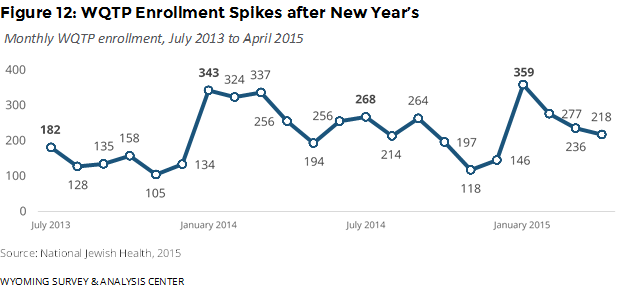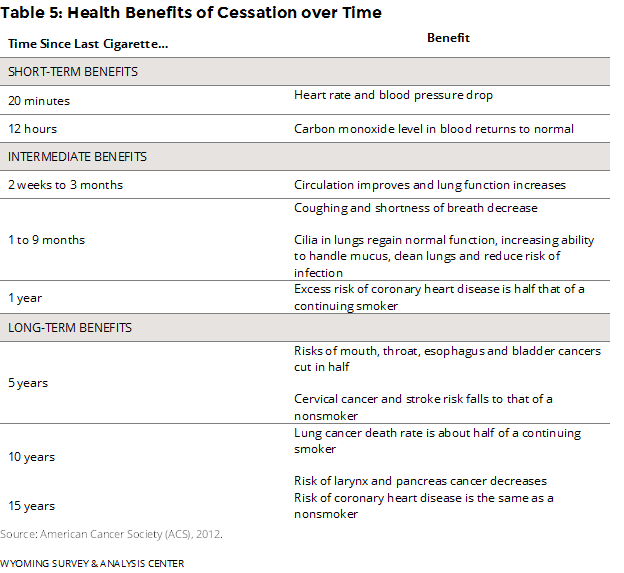 Tobacco Cessation
Tobacco Cessation
Benefits of Cessation
Smoking cessation has various short- and long-term health benefits (Table 5). Some health effects of smoking cessation (e.g., increased lung functioning) are evident within a few weeks or months of quitting, suggesting that relatively brief periods of abstinence have health benefits. Others (e.g., reduced risk of stroke) are not fully evident for five years or longer, reflecting the long-term benefits of successful smoking cessation (American Cancer Society [ACS], 2012). Additional research suggests that smoking cessation stops pathogenic processes which lead to cancer (CDC, 2010).
Cessation among Wyoming Smokers
In 2012, 86% of current smokers had made a quit attempt during their lifetime; 55% of those smokers had tried to quit within the previous year (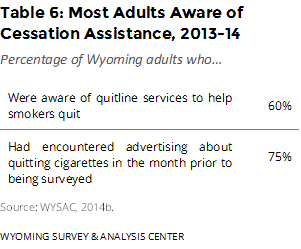 WYSAC, 2014a). Among current smokers who tried to quit in the previous year, 62% did not use the Wyoming Quit Tobacco Program (WQTP) or proven medications (nicotine replacement therapy [NRT] or prescription medications such as Chantix) during their most recent quit attempt. The most popular cessation aid was NRT: 28% of current smokers who had made a quit attempt within the previous year used NRT (WYSAC, 2014a). Most Wyoming adults said they were aware of cessation quitlines and advertisements for cessation services (Table 6; WYSAC, 2014b).
WYSAC, 2014a). Among current smokers who tried to quit in the previous year, 62% did not use the Wyoming Quit Tobacco Program (WQTP) or proven medications (nicotine replacement therapy [NRT] or prescription medications such as Chantix) during their most recent quit attempt. The most popular cessation aid was NRT: 28% of current smokers who had made a quit attempt within the previous year used NRT (WYSAC, 2014a). Most Wyoming adults said they were aware of cessation quitlines and advertisements for cessation services (Table 6; WYSAC, 2014b).
The Wyoming Quit Tobacco Program (WQTP)
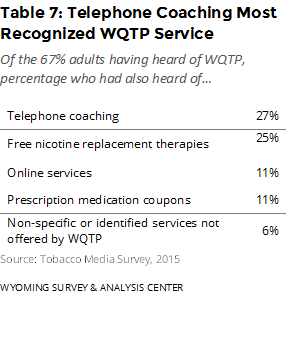 The Wyoming Quit Tobacco Program (WQTP) assists Wyoming residents who want to quit using tobacco by providing them with over-the-counter NRTs, coupons for prescription medication, and by offering them free cessation coaching services over the phone or online. WYSAC conducts a follow-up survey of WQTP enrollees seven months after their enrollment. The data in this section include information on WQTP participants who enrolled between July 2013 and April 2015. During this period, National Jewish Health provided WQTP services. WYSAC surveyed those participants seven months after they enrolled in the WQTP. Therefore, this section contains results from follow-up surveys conducted between February 2014 and December 2014 (WYSAC, 2014f).
The Wyoming Quit Tobacco Program (WQTP) assists Wyoming residents who want to quit using tobacco by providing them with over-the-counter NRTs, coupons for prescription medication, and by offering them free cessation coaching services over the phone or online. WYSAC conducts a follow-up survey of WQTP enrollees seven months after their enrollment. The data in this section include information on WQTP participants who enrolled between July 2013 and April 2015. During this period, National Jewish Health provided WQTP services. WYSAC surveyed those participants seven months after they enrolled in the WQTP. Therefore, this section contains results from follow-up surveys conducted between February 2014 and December 2014 (WYSAC, 2014f).
In 2015, 67% of Wyoming adults reported having heard of the “Wyoming Quit Tobacco Program or WQTP.” The most well-known WQTP services were telephone coaching and NRTs (Table 7; Tobacco Media Evaluation, 2015).
Enrollment and Referral Sources
Enrollment in the WQTP varies by month. Enrollment was at its lowest in November of 2013 and 2014. There were spikes in enrollment in January 2014 and 2015 (Figure 12; National Jewish Health, 2015).
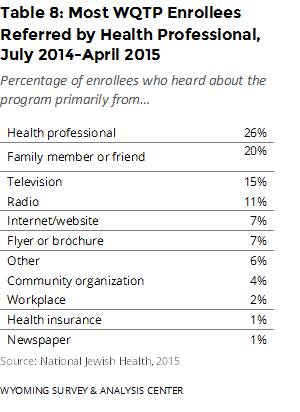 A plurality (26%) of WQTP enrollees heard about the program primarily from healthcare professionals. Many others learned of the program primarily from friends and family (20%) or on television (15%, Table 8).
A plurality (26%) of WQTP enrollees heard about the program primarily from healthcare professionals. Many others learned of the program primarily from friends and family (20%) or on television (15%, Table 8).
Use of WQTP Program Components
The majority (83%) of WQTP enrollees used at least one medication, alone or with coaching. About seven out of 10 (72%) WQTP enrollees used at least one form of coaching offered through the program, alone or in combination with medication. About three out of five (61%) enrollees used both coaching and medication (WYSAC, 2014f; Figure 13).
Success in 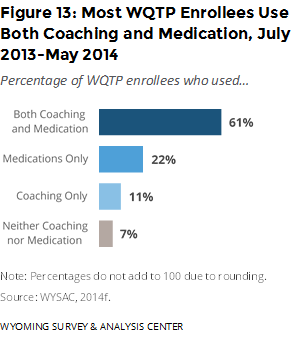 WQTP
WQTP
Seven months after enrollment, 30% of WQTP survey respondents had not used tobacco in the past 30 days. Quit rates varied by the program components enrollees used (WYSAC, 2014f):
- 33% of those who used both medication and coaching.
- 34% of those who used only medication.
- 15% of those who used only coaching.
- 11% of those who used neither coaching nor medication.

